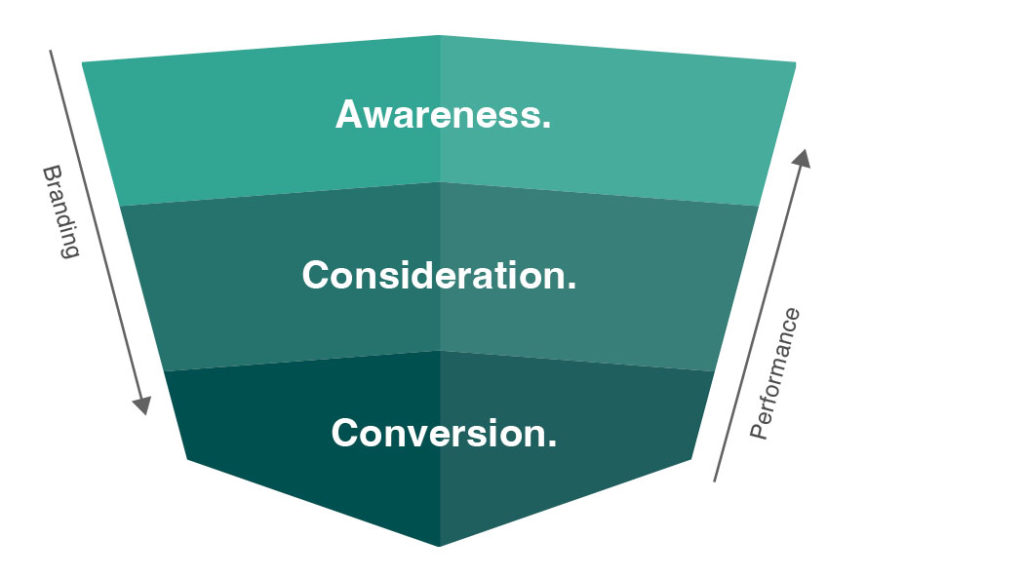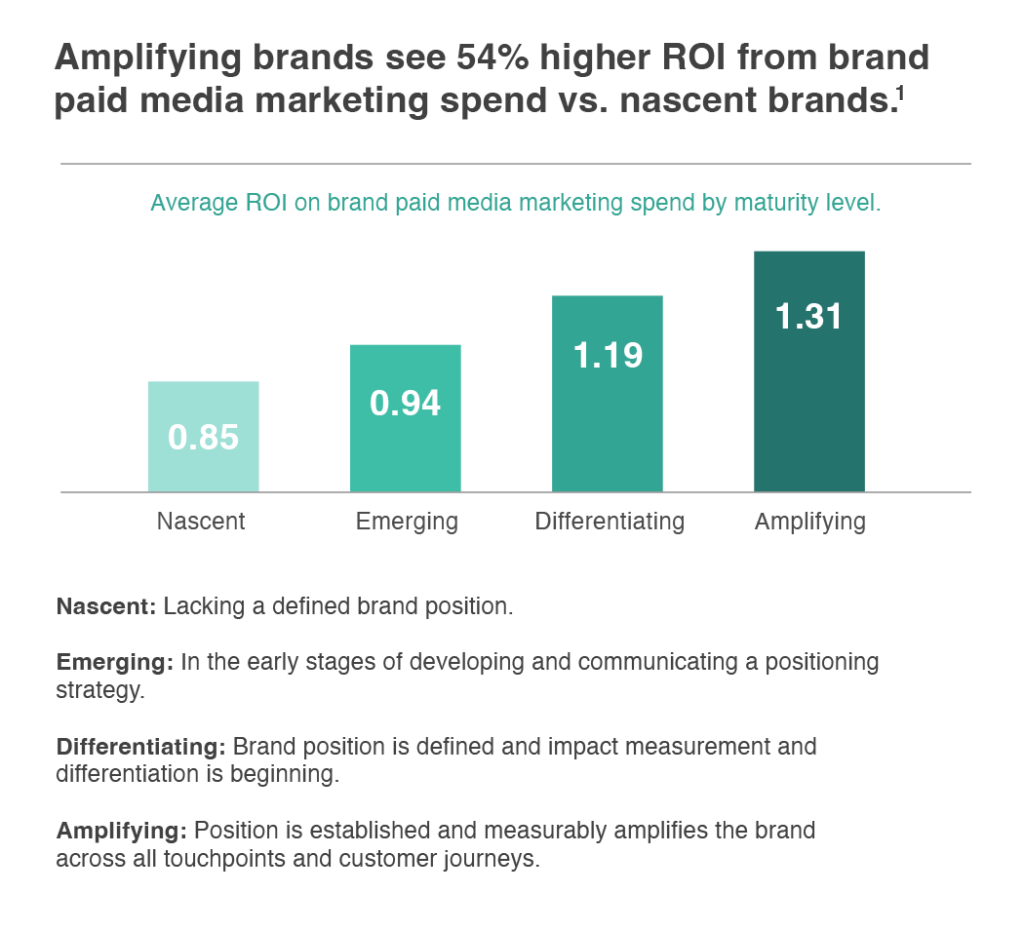In nearly 40 years of business, we can count on one hand the number of times that a client has come to us wanting “some ads just to see what happens.”
Marketing is fundamentally about driving business forward, which means that the work we do needs to ladder up to an intentional plan and vision. This is even more true when it comes to media — especially because of the transition to digital media.
Clients today don’t want to see that revenue lift is somewhat correlated with ad spend. They want to know how attributing revenue to specific media channels and keywords creates an exact return. This attribution and hyperfocus on optimization has led many brands to overinvest in performance marketing.
Performance marketing is important, but it’s not the only vital strategy to include in the marketing mix. Why? We dive into the strengths and limitations in this article and introduce our unique approach to full-funnel media.
Understanding performance marketing.
Performance marketing is a data-driven approach that focuses on achieving specific, measurable results. It involves tracking and analyzing campaign performance to optimize spending and ensure a return on investment (ROI) or return on ad spend (ROAS). Common performance marketing channels include:
- Search engine marketing (SEM): Advertisers pay for each click on their ads, driving traffic to their website or landing page. Traffic is tagged and tracked through the buying lifecycle to understand the revenue or lifetime value (LTV) associated with each click.
- Affiliate marketing: Businesses partner with affiliates who promote their products or services, earning a commission for each sale generated. This can be in the form of partnering with lead aggregators (think Expedia or Google Flights for airlines) but can also include relevant industry partnerships, such as a florist and a caterer teaming up to refer leads to one another for events.
- Social media: Targeted ads on social media platforms like Facebook, Instagram and LinkedIn reach specific audiences. These ads work much like SEM ads, but are shown to individuals with less buying intent. Because of this, targeting in these platforms is less about an audience being “in-market” for a specific product or service and more about finding users that have shown other positive buying signals.
Regardless of channel, performance marketing is rooted in the idea that every dollar in must generate the maximum number of dollars out.
When executing a performance marketing strategy, the Ervin & Smith media and strategy teams ruthlessly analyze every element of a media buy – from targeting to bids to creative – to continually optimize spend.
To navigate ever-changing market dynamics and explore the hundreds of levers we could pull to enhance performance, our team builds real-time dashboards, meets regularly to discuss results and trends, and frequently adjusts buys to ensure maximum success.
Sounds pretty great, right?
The (big) limitation of performance marketing.
While performance marketing excels at generating immediate, measurable and good-for-bottom-line results, the truth is that once you turn off the dollars going in, there will be no dollars coming out.
We generally refer to this as “media exposure” — which is shorthand for the idea that overreliance on a single channel or strategy (even one that performs amazingly) leaves the business open to risks, like:
- Major changes to media platforms or audiences reducing overall demand (this includes things like cookie deprecation, which is a BIG topic for another time).
- Competitive pressure in the media platform driving up costs to unsustainable ROI/ROAS metrics.
- Lack of bargaining or negotiating power with the media channel.
- Missing out on attention from new audiences who aren’t in the conversion stage.
In addition to these risks, performance marketing generally overlooks the potential value of long-term brand building. The focus on immediate conversions can minimize the importance of brand awareness, emotional connection and customer loyalty — which we know are critical metrics that help an organization achieve its vision.
Understanding brand awareness marketing.
Brand awareness marketing is more widely known and expected in traditional advertising. With a focus on building brand affinity, brand awareness aims to reach as many folks in the target market as possible, as many times as possible, to create recall, recognition and eventually preference.
From a media perspective, brand awareness campaigns will have higher-funnel key performance indicators (KPIs), including impressions, reach and frequency, as well as mid-funnel metrics such as clicks or traffic.
While these numbers can sometimes seem like vanity metrics (after all, who cares how many impressions you get if no one is buying?), they are good indicators of the health and relevance of a media strategy.
The best of both worlds: brand building + performance marketing.
Because performance marketing is ideal for generating immediate revenue and long-term brand building can create new and lasting value, we take a collaborative approach to build the funnel from both the top down and bottom up.
We like to call it brandformance.

The key to success lies in harmonizing performance marketing tactics with a broader brand development strategy. This integrated approach ensures that short-term gains contribute to long-term brand equity.
Google research shows that well-defined brands invested in positioning (known as Amplifying brands) can create greater than 1:1 ROAS from brand marketing efforts.

Brandformance in practice.
Practically, most businesses need to prove revenue before being comfortable (and solvent) enough to make a big bet on brand. Because of this, we take a four-step approach to implementing brandformance campaigns:
- Use performance marketing strategies to get the sales/revenue pipeline running to meet desired (and realistic) revenue goals.
- Optimize to generate excess ROAS.
- Allocate efficiency gains to new brand and conversion campaigns to generate overall revenue lift.
- Continue to reinvest excess ROAS in brand marketing, until desired brand awareness or market share is achieved.
The truth is that brand awareness can begin at any level of the funnel. And awareness ads can trigger spontaneous purchases. But we have to take a more measured approach. By combining performance marketing with brand development, we ensure immediate gains contribute to building a strong brand that stands the test of time.
Remember, a successful brand is not just about immediate sales; it’s about creating a lasting impression and fostering customer loyalty that fuels sustainable growth. Ready to see how brandformance can help you reach your media goals and build meaningful connections with your customers? Let’s connect.
Source:
- Google B2B Brand Marketing Survey
